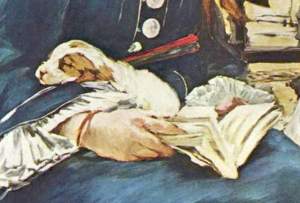
Why I Love Manet
Manet inspires me for many reasons, but I’ll focus on just one in this love letter.
Almost as soon as Manet started to paint, people criticized his choice of subjects, use of color, composition, or style of painting. One of his first critics was his teacher, Thomas Couture, who objected to Manet’s desire to portray real people in a natural manner, instead of drawing and painting professional models in heroic poses.
When Manet exhibited The Dead Christ with Angels at the Salon of 1864, that reality was too much for Manet’s critics. Théophile Thoré thought the painting showed “a cadaver,” and someone else laughingly renamed the work “The Poor Miner.”
After 1865, when Manet exhibited Olympia, insults rained down on him “like hail.” One critic said the nude figure Manet depicted was “yellow-bellied” and “vile,” while another said Olympia’s skin looked “dirty.” Others used words like grotesque and ugly. Théophile Gautier thought the whole painting was just an attempt by Manet to get attention.
It all affected Manet. After the Salon, he went to Spain. He went to look at Velázquez and El Greco, and to heal.
Hostile reactions to his work continued his whole life. In 1874, when Manet exhibited The Railway (widely known as Gare Saint-Lazare), critics said that the figures of Victorine Meurent and the little girl in the painting looked as if they were imprisoned behind bars, and that the puppy Victorine held looked like a rabbit or a seal.
Fer chrissake. Really? A seal?
One hundred and thirty-nine years later, I resent that on Manet’s behalf.
By then Manet knew what the public and critics could be like. When he spoke about Olympia, he said, “J’ai fait ce que j’ai vu.” I painted what I saw. He also said, “Il faut être mille ou seul.” You have to be as strong as a million or alone.
~~~
* The featured image at the top of the post is from The Metropolitan Museum of Art web site, www.metmuseum.org.


